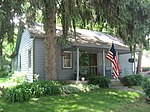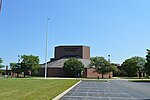Anson Davis House and Springhouse
AC with 0 elementsBuildings and structures completed in 1850Columbus, Ohio building and structure stubsColumbus metropolitan area, Ohio Registered Historic Place stubsHouses completed in 1848 ... and 3 more
Houses in Columbus, OhioHouses on the National Register of Historic Places in OhioNational Register of Historic Places in Columbus, Ohio

The Anson Davis House and Anson Davis Springhouse are historic buildings in Columbus, Ohio, United States. The house was listed on the National Register of Historic Places in 1975, and the springhouse in 1979. The two properties are the only remaining original structures from the once-extensive farm. The 137-acre (55 ha) estate was deeded to Anson Davis from his father Samuel, a veteran of the Revolutionary War.
Excerpt from the Wikipedia article Anson Davis House and Springhouse (License: CC BY-SA 3.0, Authors, Images).Anson Davis House and Springhouse
Hayden Run Road, Columbus
Geographical coordinates (GPS) Address Nearby Places Show on map
Geographical coordinates (GPS)
| Latitude | Longitude |
|---|---|
| N 40.065922 ° | E -83.12312 ° |
Address
Anson Davis House
Hayden Run Road
43002 Columbus
Ohio, United States
Open on Google Maps









